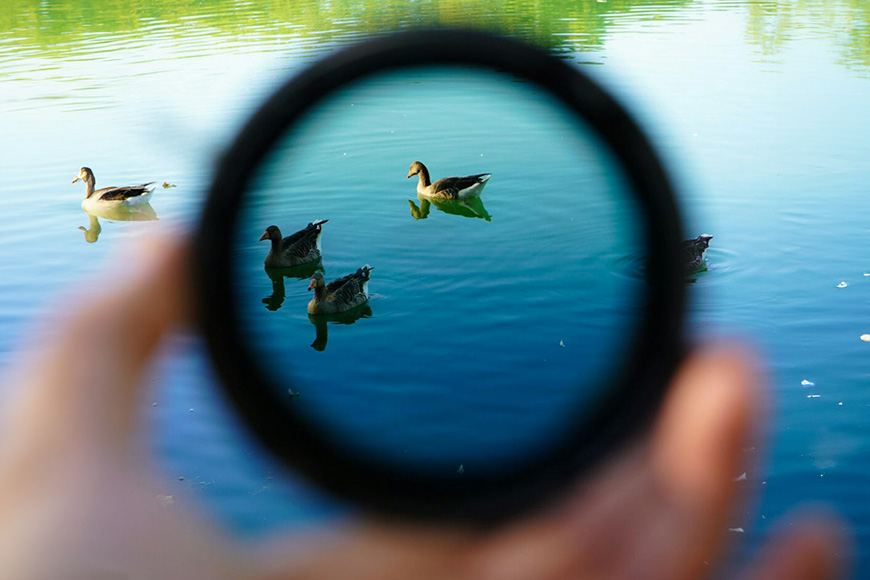
If you want to understand the differences between circular vs linear polarizers so you know which one to use, this article can be of help.
Here, I’ll explain how polarizers work and what the differences are between circular ones and linear ones.
I won’t get too technical – just enough to explain when and why you would use them, as well as their pros and cons.
I’ll also give you some recommendations to help you choose the best filter for your camera and answer some FAQs.
Sound good? Well, let’s get started!
What is a Polarizer in Photography?
Credit: Jonas Ahrentorp, CC BY SA 2.0 DEED, via Flickr.
Let’s start at the beginning. I promise I won’t go too deep into physics – for one thing, because I’m not a physicist.
So, as you probably know, light is an oscillating electromagnetic wave. We perceive the different frequencies of light waves as different colors.
Polarization specifies the direction in which these light waves oscillate.
Unpolarized light oscillates in all directions – for example, the light from the sun. Alternatively, light waves that oscillate in one direction are known as polarized.
Simply put, when the chaotic light waves traveling in all directions get organized and travel in a single direction, you have polarized light.
You’re probably wondering what all this has to do with photography. Well, have you ever photographed a landscape and gotten a bright hotspot on a water surface?
Or maybe you’ve photographed a building and ended up with distracting reflections in the windows?
Well, a polarizer in photography refers to a type of filter that helps you diminish or even eliminate glare and reflections by filtering polarized light.
There are two types of polarizing filters: linear and circular. Here, I’ll discuss how each of them works and when to use them.
To have a better understanding of how polarized and unpolarized light affect your photography, I highly recommend the book Light Science & Magic by Fil Hunter, Steven Biver, and Paul Fuqua.
Do Mirrorless Cameras Need Polarizers?
Mirrorless, like other digital cameras, can benefit from polarizing filters for taking certain types of photos.
Talking about polarizers, the difference when you use mirrorless or DSLR cameras is the type of polarizing filter you should use.
Linear and circular polarizers work well on a mirrorless camera. However, linear polarizers can cause problems on a DSLR metering system and maybe even with the autofocus.
As a side note, you can also use polarizing filters with film cameras.
Circular vs Linear Polarizer Filter: Which Is Better?
If you’re looking for polarizing filters, you’ve probably found that there are two types – circular and linear.
How Much Do You REALLY Know About Photography?! 🤔
Test your photography knowledge with this quick quiz!
See how much you really know about photography…

If you’re interested in knowing all the differences, you can continue reading as I’ll be exploring how each of them works and what are their pros and cons.
If, instead, you’re looking for the short answer to which one is better, well – the circular polarizer is usually best. In fact, it’s the most commonly sold.
Now, let’s dive in.
What’s the Difference Between a Circular and a Linear Filter?
The difference between a linear polarizer and a circular polarizer is the way each one modifies the light waves.
While circular polarizes do circular polarization, linear polarizing filters do linear polarization. So, it doesn’t have to do with the shape or with the fact that you can rotate the filter in a circle.
The type of polarization you use doesn’t influence how your photo looks. So, at first glance, it would be the same if you buy one or the other.
However, there are differences.
At first, there were only linear polarizing filters. However, at some point, they were causing problems with new technology.
Movie film cameras often use a video tap, which is a beam splitter that allows them to send the video signal out. This way, they could record video and film at the same time.
Unfortunately, the video tap uses a partial mirror to send the signal, which doesn’t work with linearly polarized light.
So, they couldn’t use a standard linear polarizer at the same time as the video tap.
It’s worth noting that a DSLR camera has a similar problem with linear polarizers. The metering and autofocus systems on the camera are on the viewfinder and are perpendicular to the sensor.
Therefore, they’re also perpendicular to the direction of the incoming light, which then gets crossed-polarized. As a result, when you use a linear polarizer with a DSLR, the metering and autofocus might not work properly.
To solve this, circular polarizers were invented. Basically, they took a linear polarizing filter and added an extra layer called a quarter wave plate.
The quarter wave plate changes the linear polarized light into circularly polarized light.
This is why I said at the beginning that, in most cases, circular polarizing filters are best – because they work well with all types of cameras, and the photographic results are the same.
You’re probably wondering why haven’t linear polarizing filters just disappeared then. Well, because each type has pros and cons that make them better for different situations.
Let’s see what they are.
Circular Polarizer Pros & Cons

Credit: Emilian Robert Vicol from Com. Balanesti, Romania, CC BY 2.0, via Wikimedia Commons
Circular polarizing filters – commonly known as CPL filters – are the most common. This is why you can find a wide variety of high-quality choices.
The good thing about a circular polarizing filter is that, unlike a linear one, it works with all sorts of cameras.
One thing you need to be aware of is that you need to find the proper orientation. The quarter wave plate should face the camera, and the linear polarizing filter should face outwards.
If it’s a screw-in filter, then it’s not a problem, but if not, you should check how you place it in front of the camera lens.
Other advantages of using a CPL filter are also shared with linear ones, which are that they can act as a neutral density filter, they eliminate reflections and glare, and they increase saturation and contrast.
What Is a Circular Polarizer Best for?
Circular polarizing filters are the best for a DSLR camera as they won’t cause any metering errors or mess with the autofocus.
Linear Polarizer Pros & Cons
Circular and linear polarizers have the same effect on the final image. Therefore, the uses and advantages are the same.
However, these can cause metering errors on a DSLR camera because the linear polarization can mess with the metering systems.
Sometimes, a linear polarizer can also affect the auto-focus sensors of a DSLR camera. So, it’s best to use them on other types of cameras.
Linear polarizers only polarize in one direction. They create vertically or horizontally polarized light, unlike circular polarizing filters, which allow circular polarization.
Also, linear polarizers don’t work well with ultra-wide angle lenses as they can create an uneven dark band.
What Is a Linear Polarizer Best for?
Take the HARD Photography Quiz! 🤯
Now it’s time to really test your photography knowledge!
(99% of people can’t get all the questions right…)

A linear polarizer is best used with a mirrorless or compact camera. This is because the partially reflecting mirrors inside DSLR cameras are incompatible with linear polarization filters.
Do You Need a Circular Polarizer?
Whether you need a polarizing filter or not depends on the type of photography you do. If you often shoot in situations where you face haze, glare, or distracting reflections, then you probably should be using a circular polarizer.
Landscape photographers are the ones who most often need a polarizing filter. This allows them to diminish or eliminate atmospheric haze created by scattered light in the air.
It also helps them to boost color saturation, which creates a beautiful blue sky and greener greens.
Since polarizing filters help you to control the glare from some reflective surfaces, landscape photographers use them when there are bodies of water in the scene.
However, this feature is also beneficial for architecture photographers, for example, as they can eliminate distracting reflections of windows.
Product photographers can find this helpful, too – if they’re shooting glasses, cars, and other products made of reflective materials.
Polarizing Filter Recommendations

Credit: Teresatrimm from Olympia, USA, CC BY-SA 2.0, via Wikimedia Commons
To choose the right polarizing filter, you need to consider more than just circular and linear polarization. You should also decide whether you want a screw-on filter or one that fits in a matte box in front of the lens.
If it’s a screw-on, make sure you check the size – this is expressed in mm, and it should match the size of your lens. You can also buy rings to adjust the size if you want them to fit different lenses.
The quality is also important. A low-quality filter may result in a low-quality image as it will lose sharpness and could create optical disruptions.
Another choice is between multi-coated and single-coated filters. Here, it’s a matter of balancing quality and budget.
To learn about these differences more in-depth, you can read this article about using polarizing filters.
These are some brands that produce high-quality polarizing filters.
- HOYA
- Lee Filters
- URTH
- Marumi
- Tiffen filters
Circular vs Linear Polarizer FAQs
Should you always shoot with a polarizing filter?
Not necessarily. Using a polarizing filter will decrease the amount of light coming through the lens. So, you shouldn’t use it if you’re working in low light – especially if you’re shooting without a tripod.
Do I need a polarizer for portraits?
Polarizing filters are not a must-have in portrait photography, but they can come in handy. They’re a good way of neutralizing any shining reflections on the skin. Also, for outdoor portraits, they help capture a more vibrant environment.
How does a circular polarizer work?
When light comes out of the light source, it’s unpolarized. However, once it’s reflected on a surface, it becomes polarized. A circular polarizer allows you to filter that light and diminish or remove that reflection.
Do circular polarizers work with mirrorless cameras?
Yes, you can use a circular polarizing filter on a mirrorless camera and still get an accurate light reading and focusing.
Highly Recommended


Check out these 8 essential tools to help you succeed as a professional photographer.
Includes limited-time discounts.
Learn more here
Credit : Source Post



